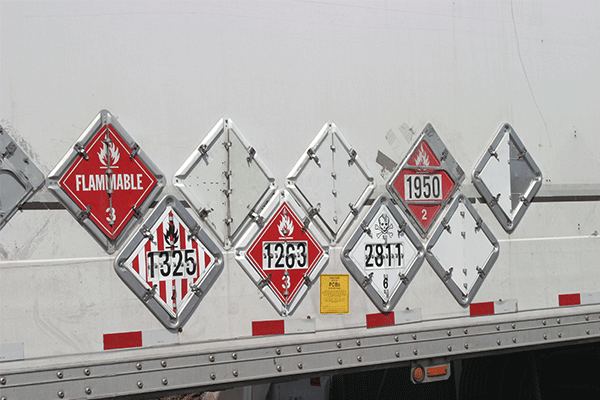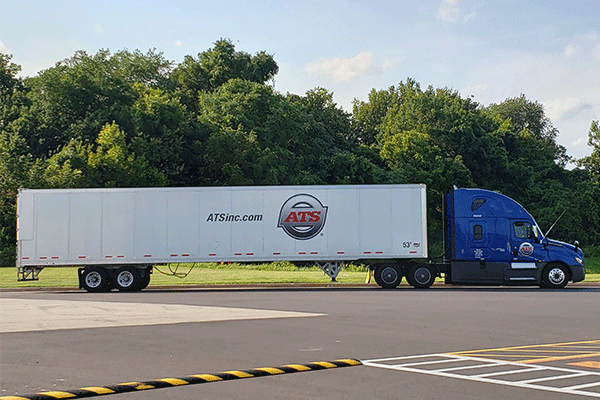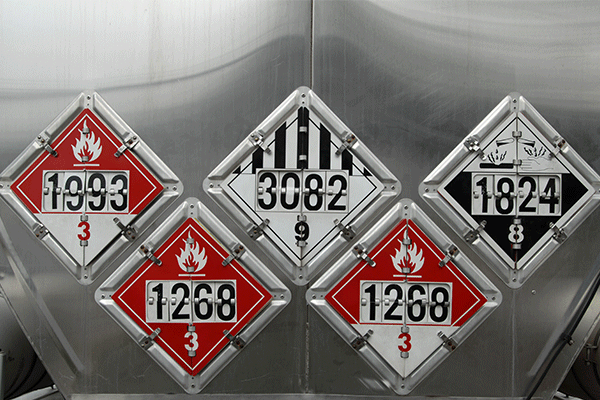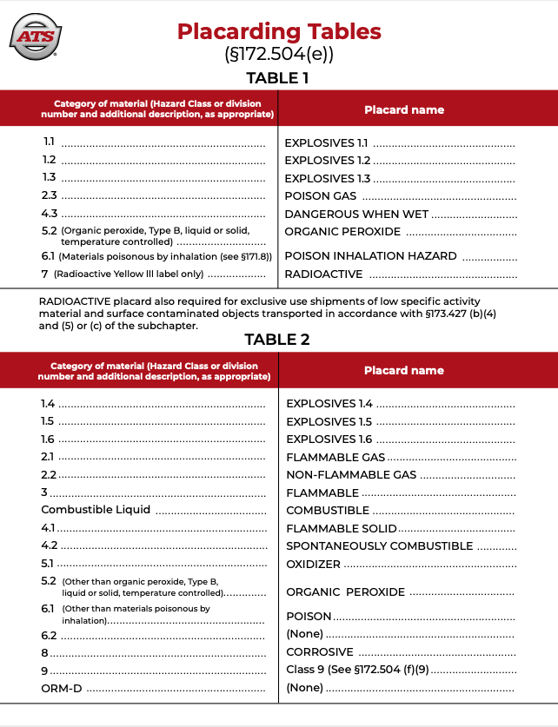
Working with freight that’s inherently dangerous to transport because it’s hazardous in some way, leaves no room for error. And, since you’re relatively new to this process, you’re here for information on what you absolutely need to know.
Keeping every stakeholder involved in the transportation of hazardous materials safe and secure every step of the way is your top priority. To do this, though, requires a significant dedication of time on your behalf. Hazmat shipping can be an intricate process, and we commend your commitment to getting it right.
Here at ATS, we’ve moved plenty of hazardous freight over the past 65 years. So, we understand how important education is to this process.
Just because hazardous materials pose a serious risk when handled improperly doesn’t mean you shouldn’t move them. Many of these products are essential to our way of life and your business’s success.
In this article, we’ll explain the most important things you’ll need to know when moving hazardous materials going forward. This includes:
- What is Hazmat shipping?
- What is a Hazmat endorsement?
- When do you need a Hazmat endorsed driver?
- What are the hazmat freight classifications?
- What is a shipper’s role in hazmat shipping?
- What is a safety data sheet (SDS)?
- What is a UN number?
- What is a broker’s role in hazmat shipping?
What is Hazmat Shipping?
Hazmat shipping is the process of moving hazardous materials — products that are harmful to humans, the environment or animals — safely within a truck from A to B. To do this requires vigilance from all parties and a thorough understanding of the product in transit.
Without handling these goods properly from start to finish, serious mishaps can occur. As such, prioritizing safety for the entirety of this process is non-negotiable.
Among other things, to move hazmat freight successfully requires a properly endorsed driver with the expertise needed to accomplish these — often dangerous — shipments.
What is a Hazmat Endorsement?
A hazmat endorsement also called an “H” endorsement is a specialized certification signifying a driver’s ability to transport hazardous materials of all kinds. Truckers are given this endorsement — signified by the letter H on their commercial driver’s license (CDL) — following the completion of a written exam and all necessary screenings.
Since this is such a specialized service offering, drivers with an H endorsement enjoy more opportunities for work than they would without. For this reason, as a driver, holding a hazmat in an otherwise tight market can be beneficial.
That said, operating as a hazmat driver comes with its own set of unique responsibilities including, but not limited to:
- Continual education on the hazmat classifications.
- Continual training on proper securement procedures.
- Continual training on transportation best practices.
- Continual education on the DOT’s placarding requirements.
Sometimes, truck drivers obtain a tanker-hazmat dual endorsement — signified by an “X” — to haul freight that is both liquid/gas and hazardous in nature. As such, to find the exact driver you need, communicate the nature of your freight clearly and accurately to your provider.

When Do You Need a Hazmat Endorsed Driver?
Any time you move freight that, according to the Code of Federal Regulations, Title 49, parts 100-185, requires the vehicle transporting it to be placarded, you’ll need a hazmat endorsed driver as well.
Placards — used to signify that the freight in transit is hazardous in nature — provide an added layer of protection for the motoring public. Whether you’ll need placards for your freight, though, depends on the classification — and gross weight of — the product in question.
When is Placarding Required?
There are two main reasons that placarding your motor carrier, and therefore, securing a hazmat endorsed driver will be necessary for your load.
Firstly, placarding your trucker’s vehicle is always required for freight that falls within a class listed in table one of the DOT's placarding tables. This holds true no matter how much (weight) needs to be moved.
For the commodities that are classified in a way that places them in table two of the DOT’s placarding tables, a different rule applies. When moving these types of freight, placarding only becomes necessary once their gross weight exceeds 1,000 total pounds.
What are the Hazmat Classifications?
Hazardous goods are broken into nine different classifications based, primarily, on the level of risk each commodity poses. From here, many of these nine hazmat classes are broken down further into separate “divisions” or sub-classes.
Each subclass gives transportation companies and hazmat shippers further instructions on how to properly handle their commodities and based on the division they fall into, their placarding classification table changes.
Let’s take a look at each of the nine hazmat classes.
Hazmat Class 1: Explosives
Explosives are commodities that pose a critical risk of combustion. This is the most severe level of hazmat classification and is broken down into six divisions.
1.1 Explosives with mass explosion hazards (ex: TNT and large explosives).
1.2 Explosives with a projection hazard (ex: bullets, projectiles and grenades).
1.3 Explosives that pose a fire hazard (ex: commercial-grade fireworks).
1.4 Explosives without significant threat of detonating (ex: consumer-grade fireworks).
1.5 Insensitive explosives or explosive agents.
1.6 detonating substances with very little risk for explosion.
Hazmat Class 2: Gases
Products that are gaseous in nature and present a risk of serious illness, injury and death if inhaled or touched. This second hazmat class is broken into four divisions that increase based on overall risk level.
2.1 Flammable gases (ex: propane, methane, acetylene).
2.2 Non-flammable, compressed gases (ex: CO2 and CO).
2.3 Poisonous gases.
2.4 Corrosive gases.
Hazmat Class 3: Flammable Liquids
Liquids that, by their nature, create a threat of combustion when introduced to fire, fall into this category. Examples of flammable liquids include, but aren’t limited to, gasoline, paint thinners and some alcohols. This hazmat class is broken down based on the temperature of their individual “flashpoints” — the point at which they’re flammable.
3.1 Flashpoint that falls below 0 degrees Fahrenheit.
3.2 Flashpoint that falls between 0 degrees and 73 degrees Fahrenheit.
3.3 Flashpoint that falls between 73 degrees and 141 degrees Fahrenheit.
Hazmat Class 4: Flammable Solids
Flammable solids are products that, when exposed to fire, will ignite. As such, these commodities require proper care and safe handling. Hazmat class four is broken down into three divisions and/or sub-classes.
4.1 All flammable solids (ex: coal, sodium batteries).
4.2 Spontaneously combustible materials.
4.3 Products that are dangerous when wet.
Hazmat Class 5: Organic Peroxides/Oxidizing Substances
Class five is broken into two divisions and encompasses all hazardous substances that produce oxygen while burning — increasing the likelihood of continuous combustion.
5.1 Oxidizers (ex: hydrogen peroxide, chlorine)
5.2 Organic peroxides (ex: fertilizers, bleach)
Hazmat Class 6: Toxic and Infectious Substances
Class six is substances that can cause serious illness and harm to humans — and other organic organisms — if inhaled or ingested. This class is separated into two divisions.
6.1 Poisonous materials (ex: nicotine and pesticides).
6.2 Etiologic (infectious) materials (ex: medical waste and substances).
Hazmat Class 7: Radioactive Substances
Any material that emits radioactive activity greater than .002 microcuries/gram. This classification isn’t broken into sub-classes but includes products that have uranium and radium in them.
Hazmat Class 8: Corrosive Materials
Materials designed to corrode in any way fall under this classification. Examples include household cleaners and lead-acid batteries.
Hazmat Class 9: Miscellaneous Hazardous Materials
Items that present a potential for hazard but don’t qualify for any of the eight other classifications. Some of the products that fall into class nine are dry ice, vehicle parts (like airbags) and lithium-ion batteries.
Typically, for class nine commodities, displaying a placard on the outside of the trailer hauling them is optional.
A Shippers Role in Hazmat Transportation
The onus of reporting the specific requirements of hazardous freight falls on the shoulders of the shipper moving it. Since these companies are the most familiar with these products, it’s up to them to educate all other stakeholders.
Clearly communicating the specifics of these products before tendering over freight to a provider is incredibly important for mitigating confusion.
To help them do this, shippers moving hazmat commodities must relay all pertinent information using a well-kept safety data sheet (SDS).

What is a Safety Data Sheet (SDS)?
Every shipper moving hazardous goods should have a highly specific SDS to present to every transportation provider they work with. These documents must outline the exact specifications of the hazardous material that needs transport including its UN number, hazmat classification quantity and any specialized safety instructions i.e. special handling and securement requirements.
Only once they have the proper information, can a transportation company — such as a brokerage — make all necessary arrangements for this shipment. As such, creating and maintaining a comprehensive SDS for every item they need moved, should be a shipper’s first priority.
What is a UN number?
A hazmat shipment’s United Nations (UN) number is the four-digit code used to signify the specific identity of the commodity in transit.
These numbers are used worldwide and should be included both on the placard of the truck transporting them and in the SDS presented by the shipper to their transportation provider.
It should be noted that many trucking companies carefully select the types of hazmat commodities they move and what they won’t. By pinpointing the UN number of each “restricted” product, carriers are able to avoid the commodities they don’t want to haul.
View the comprehensive list of UN numbers here.
A Broker’s Role in Hazmat Transportation
Like a driver needs to be properly certified to move hazardous materials, brokers must meet a similar standard. Before they can arrange hazmat loads of any kind, a freight brokerage must obtain a hazmat certification.
This certification isn’t focused on proper handling and storage of hazmat goods — like a shipper/consignees’ hazmat certifications. Instead, a brokerage’s certification is focused on compliance with the Department of Transportation’s Federal Hazardous Materials Regulations (HMR).
Since brokers work as an agent of the shipper, they are held to maintaining certain standards of hazmat transportation competency. To maintain this certification — which expires after three years — a broker must have a firm grasp on all things hazmat shipping.
This includes, but isn’t limited to:
- Hazmat classifications
- Packaging and placarding rules
- Shipment documentation best practices
Since holding this certification can be such an intricate process, be sure to ask your freight brokerage how they work to maintain their hazmat certification.
Prioritize Safety in Your Network
The importance of maintaining a safe and secure network of partners — although universally helpful — is non-negotiable when moving hazmat freight. These shipments pose a heavy chance of risk and, without proper planning can quickly get out of hand.
Reading this article was only the first step in what will become your ongoing journey toward a safe transportation supply chain.
To help further you along in this process, we’ve compiled a list of articles for you to read next. Each of these pieces will take you a bit deeper into the world of transportation safety until, eventually, you’re the master.
How Should a Freight Brokerage Monitor the Safety of its Carriers?
7 Signs To Know if You’re Hiring a Stable Transportation Provider
At the end of the day, we want to make sure you’re as comfortable as possible moving your freight. As such, please reach out to us with any questions you have. We have a transportation expert standing by to assist you in any way you need.
 Download the PDF
Download the PDF



